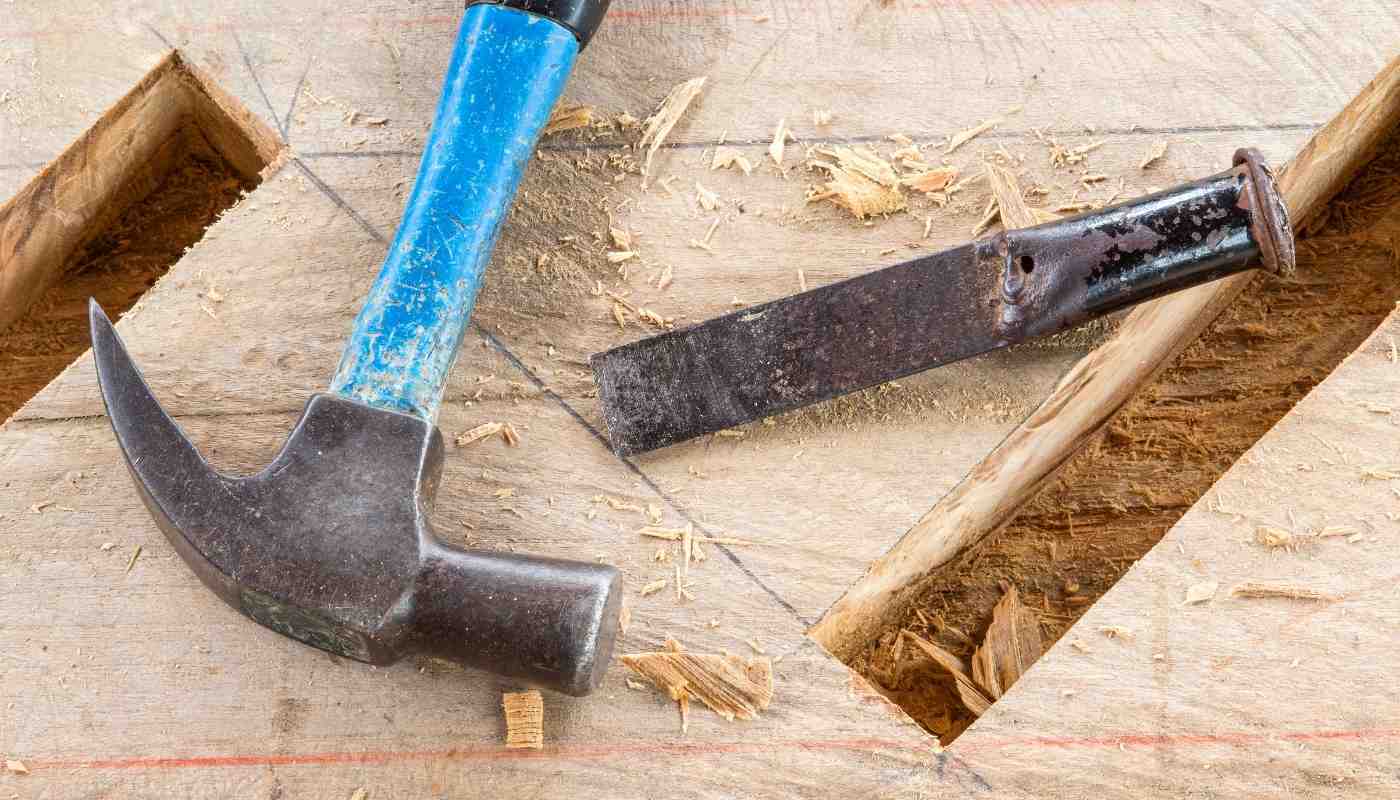How To Cut Wood Without A Saw (10 EASY Ways in 2024)
Imagine this – your favorite saw just broke, or you just realized you forgot to bring your saw to your jobsite. What do you do now?
Sure, you could go to your local home improvement store and buy a new one – but who wants to do that!?
Depending on the project, you might be able to cut wood without a saw to save you time and money.
In this post, I’ll explore how to cut wood without a saw and the advantages and disadvantages of each method. Let’s dig in!
The best ways to cut wood at home without a saw include:
- Using a wood chisel
- Using a sharp knife
- Using a drill
- Using a wood router
Best Ways To Cut Wood Without A Saw
Saws might be the go-to cutting tool for a lot of projects, but they’re far from the only option.
A well-equipped woodshop probably has dozens of potential cutting tools laying around, depending on the cut you need and the kind of wood you’re working with.
But the truth is that you don’t need a well-equipped shop to come up with at least a few alternatives.
Almost any sharp blade will be able to do some cutting, and even something as simple as a bit of wire can be used to cut wood without too much effort.
1. Use A Wood Chisel
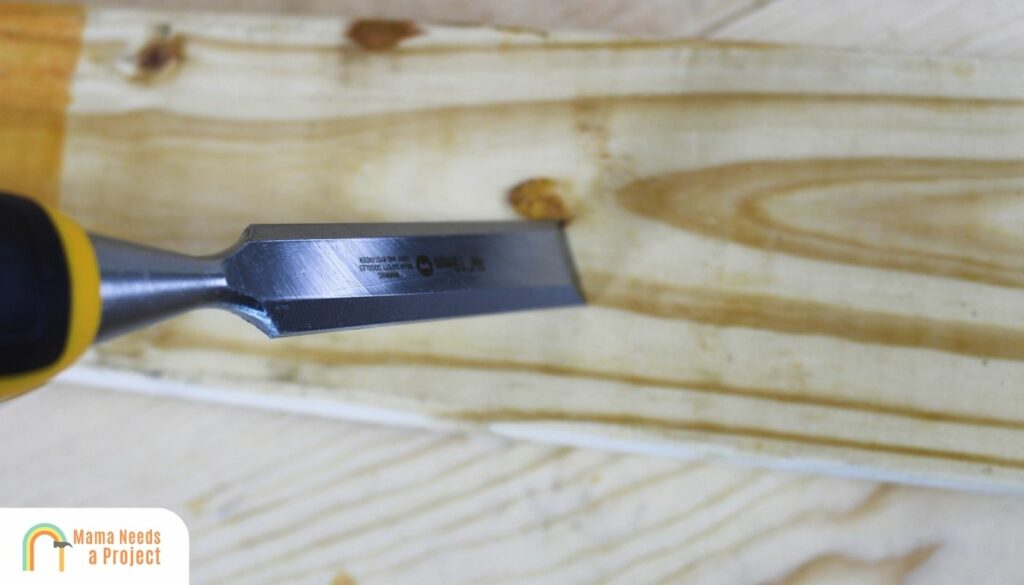
Wood chisels are often thought of as shaping tools rather than as cutting tools, but the truth is that they can be both.
A chisel can cut markings at a slanted angle, but it can also be used to cut through wood or split wood.
Different chisels are going to be good for different kinds of jobs.
For instance, a larger, heavier, chisel might be good for splitting wood, but it’s unlikely to offer the kind of precise cuts that a smaller lighter chisel can achieve.
You should also choose chisels with the type of wood you’re working in mind.
Pine is very soft and will yield to almost any chisel quickly, while harder wood types like oak or maple will need a heavier chisel or heavier strikes for even the smallest cuts.
Cutting wood with a chisel can take multiple strikes, so be prepared and understand that it takes a fair amount of patience. These tools can also be a great way to cut square holes in wood – which can be extremely handy.
If you’re trying to make a larger cut, or need a smooth finish instead of a chiseled edge, you might want to try one of the other methods on this list.
If you need to plane your wood, check out these ways to plane wood without a planer.
2. Use a Knife
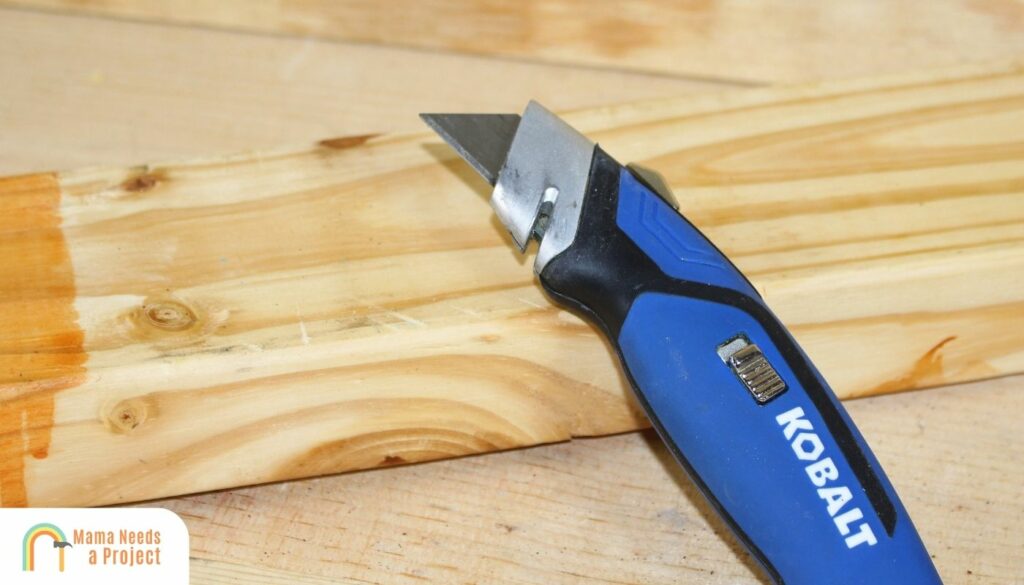
Looking to re-shape some wood or lumber but you don’t need a lot of precision?
Take a page from bushcraft and consider using a machete or knife to get the job done.
Remember that the size of the cut you’re going to get depends largely on the size of the tool you’re using.
A machete will always make larger cuts faster than a knife, but it’s also going to be significantly less precise than the knife.
Of course, you can clean up a rough cut with a knife after the fact, as long as you don’t need 90-degree angles and the smooth end you can get with a saw. (Don’t worry, we’ll offer some cutting methods that are saw-smooth a little later on.)
Knives are best for small cuts that don’t need to be super precise.
You don’t want to use a knife to carve out a complex joint, for instance. In most cases, a chisel will be faster and more precise.
However, a machete is good for rounding out the end of a log or creating a loose joint between two larger pieces of wood.
If you need a rough cut through a thicker piece of wood, a machete may also let you cut through faster than a lot of the other tools on this list.
Knives, particularly serrated knives, are better for more detailed work, but still, work best when you’re okay with rough edges or need to cut a pre-marked line. They aren’t going to give you the smooth edge of a circular saw or a perfectly straight line.
It’s also important to remember that it’s far safer and more effective to work with a sharp knife, even if that means you need to stop and sharpen it several times while you’re working.
A sharp knife is going to be more accurate, will cut edges smoother and faster, and will help make sure any accidental cuts and nicks are cleaner and will heal faster.
When you’re working with either a machete or a knife, make sure the wood is well-braced and that your non-dominant hand is well out of the way.
Machetes and knives both tend to have a higher rate of accidents than a saw blade, partially because it’s easier for the blades to skip off the wood surface since they don’t have the grip of saw teeth.
3. Cut Wood With A Drill
Do you need to cut relatively thin wood, and need a lot of precision, but don’t have a saw handy?
A drill often works as a reasonable alternative.
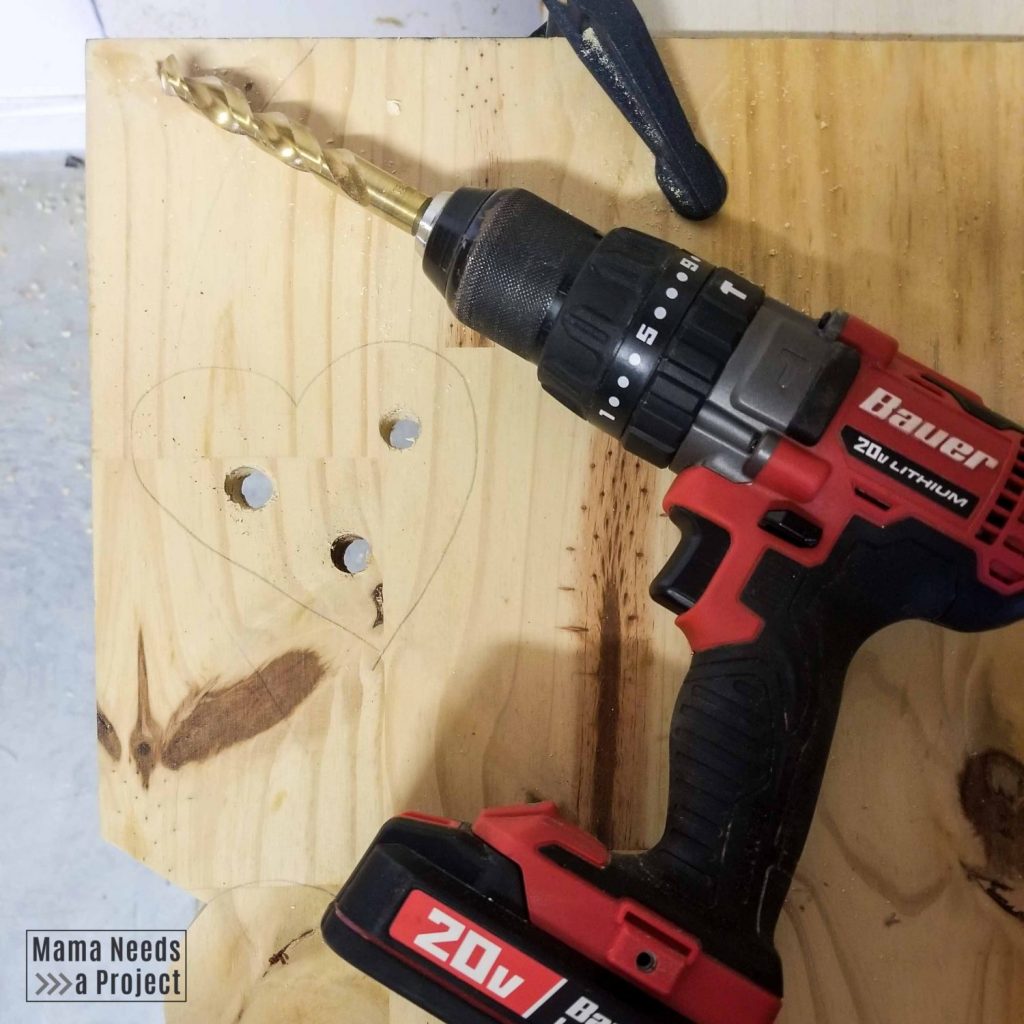
Drill presses are best, especially if the wood is thicker than an inch or so, but even a hand drill can work depending on the kind of cut you want to create.
This method is really only effective if you want a cut line – though you can use to the drill to cut more than one straight line to get the desired shape.
Curves are impossible with this method, but you’ll need to drill more holes closer together and be careful when you’re splitting the wood to make sure it doesn’t split along the grain instead of along the curve.
Using a drill to cut wood is basically the same as tearing perforated paper.
You’ll drill holes through the wood along the desired cut until the piece is weak enough you can break it apart along the desired line.
In fact, this method can sometimes be faster than using a hand saw, depending on the size of the cut you want to make and the hardness of the wood.
However, like most wood cutting methods, the harder your piece of wood is the more time it will take and the harder it will be to cut wood without a saw.
As a rule of thumb you want to drill about twice as many holes as you think you’ll need to get a smooth cut, and width between holes should be no wider than the width of the holes themselves.
It might seem tedious to drill that many holes in a row, but when you see how efficiently the cut wood comes apart at the end, it’s worth it.
The edge won’t typically be smooth at the end of this process, but you can smooth it with a knife, some sandpaper, or a grinder.
4. Try A Router
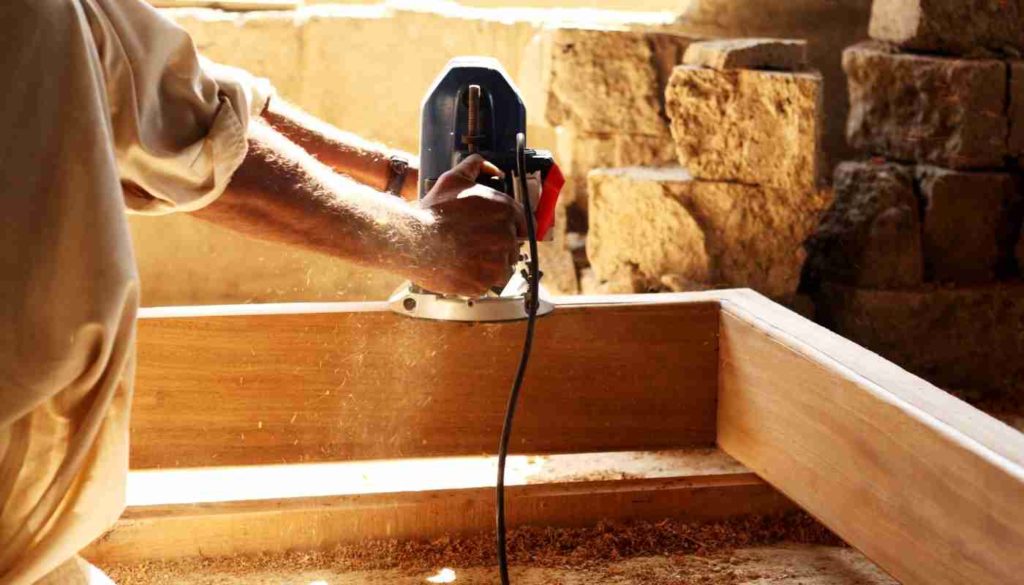
A wood router is another good option for cutting wood, especially if the project you’re working for calls for thin wood and a very smooth edge.
Cutting wood with a router can be a tricky process though.
Remember that the router is just as capable to cut through whatever is under the wood as it is to cut through the wood itself.
Basically, the process is the same as using a wood router to decorate a wood surface, but instead of cutting part way through you’ll use the depth adjustment tool to cut slightly thicker than the wood you’re working with.
Alternatively, you can use the depth adjustment to set the router almost as thick as what you’re cutting and break the wood piece when you’re done. However, that comes with the risk of splintering or splitting, which means it’s not as effective if you need a sharp edge or a perfectly even wood surface.
If you need something better than rough cuts, using a router is a good option.
However, you’ll need a different tool if the wood you want to cut is thicker than your router bit and depth adjustment tool can handle.
Ideally, you want to make a router cut with a single pass, multiple passes can create roughness or an uneven edge if you aren’t perfectly lined up.
However, when a router works – you’ll get basically the same results as you would get from a circular saw, jigsaw, or hand saw.
Just remember that routers are some of the more dangerous power tools you can work with because it’s incredibly easy to forget how powerful they are, and because they create cuts that are incredibly difficult for your body to heal.
The biggest advantage of working with a router is that they can create curved cuts a lot more easily than other tools.
One way to take advantage of that is to use a router to create a guideline, and then complete the actual cut with a knife, chisel, or another tool for cutting wood.
The channel will help create a smoother cut and provide some additional grip, so your tool will work more like a saw blade.
Remember, sometimes the best option is to combine different wood cutting tools to get the desired outcome.
5. Limited Tools? Use Wire
Wire might seem like an odd choice for cutting wood, but a wire cutter actually functions almost identically to a jigsaw, but without the teeth.
Thicker wire will usually take slightly longer to cut, remember that you’re using friction to cut and thinner wire helps concentrate that friction into a smaller area. On the other hand, wire that’s too thin will break often and make life more difficult.
The easiest way to wire cut wood is to get a length of wire slightly wider than your project. You want at least 2 inches of wiggle room to move back and forth.
Wrap both ends of the wire around a wooden dowel or similar tool, and pull the wire back and forth to create friction.
Wire cutting creates one of the smoothest edges aside from using a saw blade, and can be used to cut straight or curved lines, thick or thin wood, decorative details or rough chopping.
The biggest problem with this cutting method is that it takes a lot of time if you’re working with hardwood or a thicker piece of wood.
It can also take some practice to really get the sawing motion down, and to avoid putting so much tension on the wire that it snaps.
It can help to use a chisel or a knife to give yourself a guide before you begin cutting, that way you don’t need to worry about the wire slipping while you’re pulling back and forth.
For small pieces, wire cutting can actually be more effective than using a saw because you can be a lot more precise and manipulate the wire in ways you can’t effectively manipulate a saw blade.
6. Lathes Are Cutting Tools Too
When most woodworkers think of a lathe they think of beautiful round projects from spindles to bowls and vases. While that’s the primary use of a lathe, you can also use them to cut wood.
There are a few limitations to using a lathe.
For one thing, the vast majority of the time you should not cut all the way through your wood on the lathe.
Instead you’ll cut down to a thin connection and then break the wood off when you remove it from the lathe. A sharp edge like a sharp machete can be used, but most of the time you can just break the connection with your hands.
Additionally, lathes work best when you either have some scrap wood that you don’t mind cutting into a curve to access your cutting point, or if you’re working on a rounded project that needs to come to a tip anyway.
Remember, lathes are always going to create dowels, circles, and curves.
While you can use them to get a straight cut on the flat side of a project, you’ll need at least one curved side to get a straight line cut without putting yourself, your tools, or the lathe itself at risk.
You also need to remember that lathes always come with some risk of injury.
A lathe is not a circular saw replacement, and if you want to avoid injury you should only use them for cutting if you already have some lathe experience.
That said, this is a great option for a large piece of wood, pieces of wood that have already been joined together, or if you need a clean cut on a cylinder or similarly shaped piece of wood.
Lathes are also likely to be one of the fastest and most precise ways to get a clean cut. You just need to understand their limitations.
7. The Knife And Baton Method
Knife and baton is a variant on cutting with a knife and cutting with a chisel.
Like using a chisel, the idea is to lay the knife on the wood you want to cut, and then to strike the back of the blade with a baton to actually cut.
The knife acts like a wedge, usually splitting the wood cleanly for a smooth cut, but you’ll need to learn to work with the grain of the wood and spot unintentional splits to get good at this method.
It’s important to remember that you need to use a baton, preferably made from wood or covered in a soft material like leather, not a hammer.
Chisels are specifically hardened to handle a hammer strike, knives are not.
That means that if you hit a knife with the same hammer you would use on a chisel you’ll end up with a bent, dented, or otherwise broken knife.
This option is good for when you need to improvise since almost anything that’s softer than the knife can be used as a baton, and it’s a flexible cutting method good for a wide range of small cuts. However, it’s not going to be as effective as a chisel for large pieces of wood or hardwoods.
Remember, just like carving or whittling with a knife, you need to take breaks to sharpen your knife if you want this method to be effective.
A sharp edge will make the work faster, more precise, and limit the odds of the wood splitting badly.
8. Try The Ringing Method
Ringing is a good way to bring a circular or otherwise uneven piece of wood down to size if you don’t have a saw or lathe available.
You’re essentially going to use a knife to cut straight paths across the diameter of the wood at an angle over and over.
As you work your way around the wood you’ll gradually reduce the diameter of the wood while mostly preserving it’s roundness.
Ringing is also a good way to take an uneven piece of wood and create a circular attachment point at the end.
However, like most of the other methods of cutting with a knife, this process is slower than if you did the same thing with a saw.
It’s main advantage is that it can be done with a sharp hunting knife or almost any other knife that’s hard enough. You don’t need the right tools to make this work.
Ringing can also be done as a variation on the knife and baton method, where you strike with a baton to cut instead of sawing or chipping with the knife. It’s typically faster when you use a baton, but may not be as precise.
9. Use A Good Old-Fashioned Axe
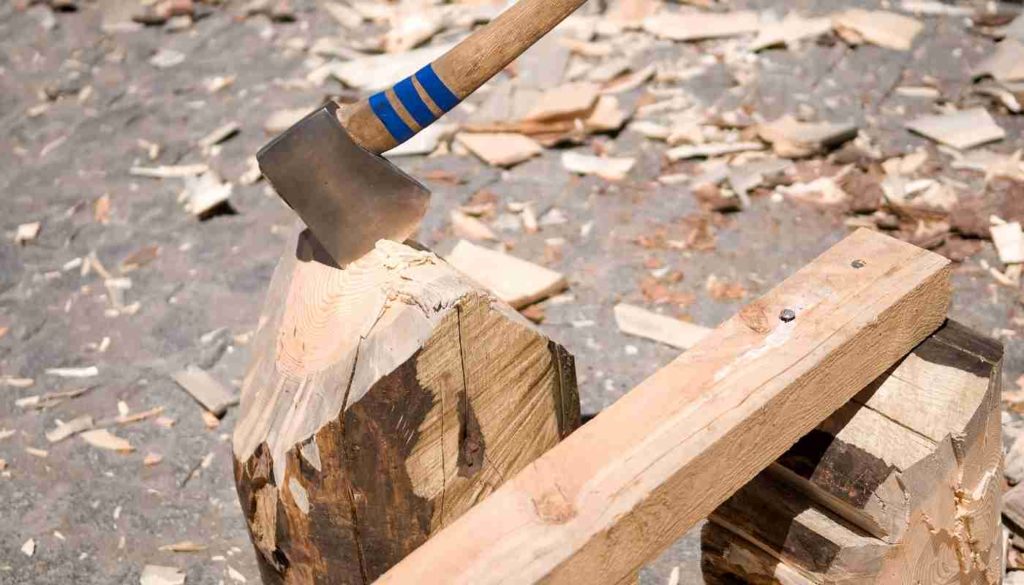
Just need to rough cut a lot of wood down to size or get it ready for other kinds of finishing work?
An axe can do a lot of the same work you might use a saw for, as long as you don’t need a smooth work surface when you’re finished.
An axe blade is specifically designed to split the grain of wood, or to cut through the grain without dulling as quickly as other blades.
That makes them ideal for cutting a wood piece to size, splitting firewood, or getting a large chunk of wood down to more maneuverable sizes.
10. Smaller Project? Use A Hatchet
Need the same kind of cutting power you can get out of an axe, but working on a smaller scale?
Hatchets aren’t quite small axes, there are some design differences that make them work differently on the wood, but they accomplish the same basic purpose as an axe, and tend to be easier to keep around.
Hatchets are also typically small enough to use for some carving and smoothing purposes, making them a bit more multi-use than your typical axe.
How To Figure Out Which Method Is Best For Your Project?
When you have access to a circular saw, hand saw, and other tools that are perfectly designed for your needs it’s often easy to decide which one you need.
But when you’re stuck cutting a straight line with a drilling machine or doing detailed decoration with a wire for a cutting tool, it can be harder to know which tools are right for the job.
Remember that often the most precise tools are the least versatile.
So a knife or a wire might be good for making a more precise cut, but they’re going to be more limited when it comes to cutting large chunks of wood.
When you’re deciding what tool to try there are a few things you should consider:
- Is precision more important than speed?
- How much wood am I working with? Do I need to start with a larger less precise tool and move to a more precise one?
- Am I working with hardwood that will be difficult to cut or softwood that will split easily?
- Am I cutting with the grain or against the grain?
- Am I creating a smooth cut, or is roughness okay?
- Am I creating a joint or simply cutting wood to shape?
- Do I have what I need to keep my tools sharp, or will they dull as I work on the project?
- Do I have wood to spare, or do I need to minimize my wasted material?
The answers to these questions, along with knowledge of what each of your tools is best suited for will help you decide what to try and where to start.
Are There Any Jobs Where A Saw Is The Only Option?
Yes and no.
In the hands of a skilled craftsperson, a knife or chisel can probably be made to do anything a saw could do, but it might be more difficult than using the saw.
The type of blade you’re working with, as well as the type of wood and the shape you’re going for, can all influence tool choices.
If you don’t have a lot of skill and experience there may be some jobs that you can only accomplish with a saw. But with practice, most jobs are possible, even if you don’t have the right tools.
Are There Any Other Tools To Cut Wood Without A Saw?
There are probably lots of other tools you can use to cut wood without a saw.
For instance, stone age people knew how to use stones and knapped obsidian to cut wood and even create planks and lumber.
Your toolset is limited only by your ingenuity, experience, and knowledge.
If you have free time away from your projects it’s a good idea to experiment and see how different tools, or even non-tools, work.
The more you know the more prepared you are if something breaks suddenly, you forget a tool or your normal tools just aren’t cutting it for a project.
Final Thoughts
Cutting wood without a saw can seem impossible, but fortunately there are several options to choose from.
Hatchets, chisels, wire, and other tools can all be used to cut wood, depending on the project you’re working on.
Remember to take into account the type of wood, the shape you’re going for, and your own skill level when deciding which tool to use.

